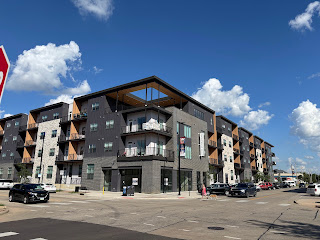I like all of the plans because they're making changes for the right reasons: better service, more attractive to potential riders, with more efficient use of the budget. I like the small steps of Concepts 1 and 2; I am less inclined to support Concepts 3 or 4 until they're justified by increased ridership.
The incremental plan, Concept 1, straightens some existing routes, meaning it would be more rational for people to choose the bus for transportation. Most intriguingly, it adds an express bus along route 5--which has, by far, the highest ridership of existing routes--from downtown Cedar Rapids to Lindale Mall and the surrounding plazas. This involves no additional financial cost, but involves loss of service to some areas that are more suburby and don't produce much ridership anyhow. (There's a hedge version of this plan that continues service along O Avenue NW, so that it doesn't look like they're abandoning the northwest side so much.)
Transit Concept 2 is more creative while still being close to cost-neutral. (It would require about $75,000 in additional funding to hire one additional driver.) It extends service into the evening along some routes to 10:00 p.m. instead of the current 7:00 p.m. This wouldn't necessarily help second-shift workers, but could be useful for evening shoppers. The tradeoff would be peak time service on routes other than #5. (Most routes now run two buses an hour instead of one between 5 and 8 a.m. and between 3:30 and 5:30 p.m.) This is an interesting proposal, but I don't have the data to judge whether it would be a positive exchange.
Transit Concept 3 would have fewer tradeoffs but would require a revenue increase. At this level they could run buses til 11 and keep the daytime peak hour runs. It require the three towns served by the transit system to increase their contributions to the maximum allowed by the state--95 cents per $100,000 of property value--which may be a non-starter given that Cedar Rapids (currently at 80 cents) has just shot down a library levy, and Hiawatha and Marion are currently at less than one-fifth of this target.
Transit Concept 4 would elaborate the hub system so there could be shorter routes that connected at strategic locations around town. I'm not sure how much additional funding this would require, but it would be an alternative universe to the one C.R. Transit lives in now. It's useful as a vision of how transit could contribute to the quality of life in some future, walkable version of Cedar Rapids, but we're not there yet.
Houston might be, though!: https://player.vimeo.com/video/160988232 [5:20 video from StreetFilms titled "Houston is Back on the Bus"
EARLIER POSTS
- "Mass Transit, Here and There," 17 February 2016, http://brucefnesmith.blogspot.com/2016/02/mass-transit-here-and-there.html
- "Envision CR III: Improve Public Transportation," 6 April 2015, http://brucefnesmith.blogspot.com/2015/04/envision-cr-iii-improve-public.html
- Human Transit, the professional blog of public transit consultant Jarrett Walker
- The Transport Politic, by Yonah Freemark, currently based in Chicago
- Strong Towns has just compiled a week of posts on transportation issues; founder and president Charles L. Marohn has written A World-Class Transportation System (2014)











